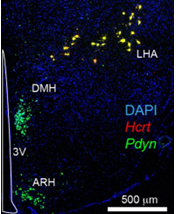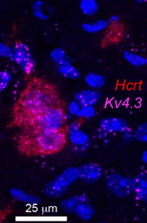The Stincic Lab has recently incorporated RNAscope (ACDBio) technology into their research. This in situ hybridization approach labels messenger RNAs to quantify gene expression in mouse brain sections. This enables the simultaneous detection of three genes in individual neurons. The labeling patterns are then captured in high resolution using the Laser Scanning Confocal microscope.
The Stincic lab studies how estrogen controls hypothalamic neurons that maintain homeostasis by balancing activity and food intake. The focus of this project is to investigate sex differences in subpopulations of orexin neurons. Dysfunction in orexin neurons causes narcolepsy in animals and humans. However, these neurons are also involved in motivation for foods high in fat and sugar. RNAscope is being used to determine if orexin neurons can be divided into subpopulations that separately control these two behaviors and whether they are regulated differently by estrogen. The results from these experiment will help understand why women are more susceptible to insomnia, eating disorders, and obesity compared to men.
This research was funded by a URC Grant to Dr. Stincic.

Figure 1. Prepro-orexin (Hcrt) and prodynorphin (Pdyn) mRNA labeling. Hcrt labeling is confined to a small population in lateral hypothalamus. The yellow labeling shows that all Hcrt neurons also express Pdyn

Figure 2. mRNA labeling in individual neurons. ORX neurons (red) express Kv4.3 (magenta) an inhibitory potassium ion channel. Hcrt labeling is diffuse compared to Kv4.3 as neuropeptides are translated in the cytoplasmic ribosomes, not the rough ER. Blue=DAPI nuclear stain.
